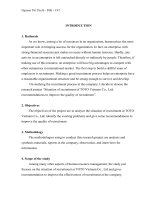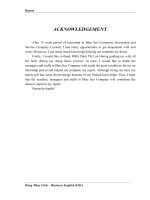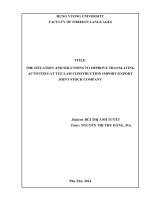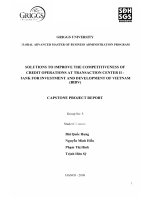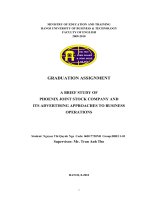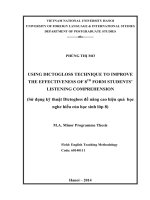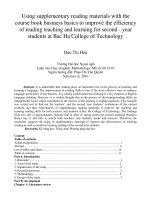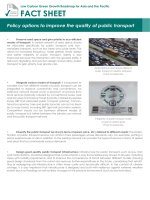Recommendations to improve the process of bulk carrier operation of VINASHIP joint stock company
Bạn đang xem bản rút gọn của tài liệu. Xem và tải ngay bản đầy đủ của tài liệu tại đây (1.56 MB, 53 trang )
-
MINISTRY OF TRANSPORTATION
MINISTRY OF EDUCATION & TRAINING
VIETNAM MARITIME UNIVERSITY
STUDENT NAME:DANG DINH DUNG
DISSERTATION
GLOBAL STUDIES AND MARITIME AFFAIRS
RECOMMENDATIONS TO IMPROVETHE PROCESS OF BULK
CARRIER OPERATION OF VINASHIP JOINT STOCK
COMPANY
HAI PHONG – 2015
MINISTRY OF TRANSPORTATION
MINISTRY OF EDUCATION & TRAINING
VIETNAM MARITIME UNIVERSITY
STUDENT NAME:DANG DINH DUNG
CLASS:
GMA02
DISSERTATION
GLOBAL STUDIES AND MARITIME AFFAIRS
RECOMMENDATIONS TO IMPROVETHE PROCESS OF BULK
CARRIER OPERATIONOF VINASHIP JOINT STOCK
COMPANY
Supervisor:
LecturerVuong Thu Giang
Division:
Global Study and Maritime Affairs
Faculty:
Economics
HAI PHONG – 2015
Recommendations to improve the process of bulk carrier operation of VINASHIP Joint Stock
Company
PREFACE
This dissertation has been accomplished upon three month working experience in
OperationDepartment of VINASHIP Joint Stock Company. This writinghereby will
demonstrate the full process of bulk carrier operation of the company. Besides, I will
analyze the process and also evaluate its efficiency in performance comparing to the
standard process which is stated in Chapter 1 hereby recommend possible solutions
for improvement.
I hope that this dissertation can help readers in gaining somewhat general knowledge
but also features about bulk carrier operation.
I declare that this report is my own unaided work. It has not been submitted
before.
If violated, I am solely responsible for and bear the punishments of the Institution and
University.
Student Name and Signature
ĐặngĐìnhDũng
i.
ĐặngĐìnhDũng GMA02
Page i
Recommendations to improve the process of bulk carrier operation of VINASHIP Joint Stock
Company
ACKNOWLEGEMENT
Firstly, I would like to express my sincere gratitude to my advisor Prof. Vuong Thu
Giang for the continuous support of my study and related research, for her patience,
motivation, and immense knowledge. Her guidance helped me in all the time of
research and writing of this thesis. I could not have imagined having a better advisor
and mentor for the accomplishment of this dissertation.
Besides I would like to thank sincerely Vice General Director, Shipping Manager and
colleagues in Operation Department at VINASHIP Joint Stock Company for being
very supportive and cooperative to myself during my internship. I am grateful that
they have provided me the best opportunity to learn and experience in a professional
working environment.
i.
ĐặngĐìnhDũng GMA02
Page ii
Recommendations to improve the process of bulk carrier operation of VINASHIP Joint Stock
Company
TABLE OF CONTENTS
Preface......................................................................................................................... i
Table of Contents ....................................................................................................... ii
List of Symbols, Abbreviations.................................................................................. iii
List of Tables and Graphs .......................................................................................... iv
List of Figures ............................................................................................................ v
INTRODUCTION ...................................................................................................... 1
CHAPTER 1: Literature Review................................................................................. 3
1.1Definitions of bulk carrier and ship operator .......................................................... 3
1.2Method of bulk carrier operation............................................................................ 3
1.3 Ship’s particulars .................................................................................................. 3
1.4 Documents and Certificates required to be carried on board ships ......................... 7
1.5 Concerned parties ................................................................................................ 9
1.6 The international convention and national regulations related to the responsibilities
of the parties ............................................................................................................. 10
1.7 Contract to be used ............................................................................................ 10
1.8 The process of bulk carrier’s operation (voyage charter) ..................................... 12
CHAPTER 2: The practical process of bulk carrier operation at VINASHIP Joint
Stock Company ........................................................................................................ 16
2.1 Overview of VINASHIP Joint Stock Company................................................... 16
2.1.1 History ............................................................................................................. 16
2.1.2 Organization .................................................................................................... 17
2.1.3 Personnel and Infrastructure ............................................................................. 18
i.
ĐặngĐìnhDũng GMA02
Page iii
Recommendations to improve the process of bulk carrier operation of VINASHIP Joint Stock
Company
2.1.4 Business Sphere and Department ofOperation ................................................. 19
2.2The bulk carrier operation at VINASHIP ............................................................. 20
2.2.1 Chartering ............................................................................................................
2.2.2 Pre-voyage ...........................................................................................................
2.2.3 Vessel Departure to Port of Loading ....................................................................
2.2.4At Port of Loading ................................................................................................
2.2.5 Departure and Sailing to Port of Discharge ..........................................................
2.2.6At Port of Discharge .............................................................................................
2.2.7 Post-voyage .........................................................................................................
CHAPTER 3: Recommendation to improvethe process of bulk carrieroperation of
VINASHIP Joint Stock Company ............................................................................. 28
3.1 Advantages and Disadvantages of the bulk carrier operation of VINASHIP JSC 28
3.2Business Result and Analysis ............................................................................... 29
3.2.1 Strengths ..............................................................................................................
3.2.2 Weaknesses .........................................................................................................
3.2.3 Opportunities .......................................................................................................
3.2.4 Threats .................................................................................................................
3.3 Recommendations............................................................................................... 32
CONCLUSION
Reference / Bibliography .......................................................................................... 36
Appendices ............................................................................................................... 37
i.
ĐặngĐìnhDũng GMA02
Page iv
Recommendations to improve the process of bulk carrier operation of VINASHIP Joint Stock
Company
LIST OF ABBREVIATIONS
OBO
Oil-Bulk-Ore Carrier
SOLAS
Convention for Safety of Life at Sea
LOA
Length Overall
LBP
Length Between Perpendicular
LWL
Length on Load Waterline
DWT
Deadweight Tonnage
GRT/RT
Gross Register Tonnage/Gross Tonnage
NRT/NT
Net Register Tonnage/Net Tonnage
STCW
Standard of Training, Certification and Watchkeeping
MARPOL
International Convention for the Prevention of Pollution from Ships
AFS
International Convention on the Control of Harmful Anti-fouling
systems on ship
CLC
International Convention on Civil Liability for Oil Pollution Damage
MSC
Maritime Safety Committee
ROROC
Report on Receipt of Cargo
B/L
Bill of Lading
MLC
Maritime Labor Convention
C/P
Charter Party
BIMCO
Baltic and International Maritime Council
NYPE93
New York Produce Exchange Form
GENTIME
General Time Charter Party
COA
Contract of Affreightment
i.
ĐặngĐìnhDũng GMA02
Page v
Recommendations to improve the process of bulk carrier operation of VINASHIP Joint Stock
Company
VOLCOA
Standard Volume Contract of Affreightment for the Transportation of
Dry Bulk Cargoes
ETA
Estimated Time of Arrival
NOA
Notice of Arrival
NOR
Notice of Readiness
LOI
Letter of Indemnity
COR
Cargo Outturn Report
SOF
Statement of Facts
TPP
Trans-Pacific Partnership
i.
ĐặngĐìnhDũng GMA02
Page vi
Recommendations to improve the process of bulk carrier operation of VINASHIP Joint Stock
Company
LIST OF TABLES/FIGURES
TABLE 1: VINASHIP Fleet ..................................................................................... 16
FIGURE 1: Ship dimensions....................................................................................... 3
FIGURE 2: Loadline and Plimsoll Mark ..................................................................... 4
FIGURE 3: Company struture .................................................................................. 15
i.
ĐặngĐìnhDũng GMA02
Page vii
Recommendations to improve the process of bulk carrier operation of VINASHIP Joint Stock
Company
INTRODUCTION
Shipping is one of the most important industries having close ties with the
development of foreign trade. The country which has a developed shipping industry
can perceive many advantages in foreign affair as well as increase the national
revenue. Moreover, it also promotes the interchange of diverse cultures between
regions worldwide. Vietnam is a coastal country with a long coastline of 3200 km
and has many favorable geographical locations for the development of maritime
transportation. The national shipping industry, therefore, requires a continuous
innovation and improvement in terms of scale, organization, quantity and quality,
productivity, professionalism… in order to keep pace with the growing demand.
Considered as a typical model, the VINASHIP Joint Stock Company (VINASHIP)
is the leading corporation amongst many that operate within the industry.
Amongst different departments in a shipping company, Department of Sales
and Operationcan be considered as the most essential body of the company that it
contributively assists the board of director in making decision towards their
business. As the shipping industry is requiring from participants to comply with
more new legal, commercial, technical and operating standards, research on
professional competence and working practice of the departmentthus is highly
necessary
especially
for
myself
as
a
student
of
Vietnam
Maritime
Universitywhereby I had a deeper understanding of their business and been aware
of strengths and weaknesses. Current strengths must be made the most while
existent shortcomings must be minimized and remedied as soon as
possible.Hopefully all the recommendations proposed for improvementof
productivity and efficiency shall be taken into considerationby the company
managers.
This dissertation includes three main chapters as what I mentioned in the
content above. In the first chapter which is the Literature Review, I will introduce
the basic knowledge of shipping, technically by giving out sufficiently broad
concepts, terms and some particulars. This chapter is supposed to clarify the
technicalities used in the operation and provides various basic stagesin bulk
carrier’s operation. On the other hand, the next chapter focuses on what I actually
obtained through research, work and observation during my apprenticeship at
Department of Operation of VINASHIP, containing the background of the
ii.
ĐặngĐìnhDũng GMA02
Page 1
Recommendations to improve the process of bulk carrier operation of VINASHIP Joint Stock
Company
company, its business spheres and professions of the department where I involved
in.The profession will be described in detail as I have the permission from
VINASHIP to use some of their documents as samples through outthis dissertation.
In the final chapter of the dissertation, the financial result of the company will be
provided hereby I will draw my infrences along with SWOT analysis. For further
development of the company, I would be very fortunate to recommend the company
with some recommendations listed afterward so that the company shall be able to
maintain its good working practice or even to improve the overall productivity.
ii.
ĐặngĐìnhDũng GMA02
Page 2
Recommendations to improve the process of bulk carrier operation of VINASHIP Joint Stock
Company
CHAPTER 1: LITERATURE REVIEW
1.1 Definition of Bulk Carrier and Ship Operator
There are several definitions of bulk carriers. According to the International
Convention for the Safety of Life at Sea (SOLAS) chapter IX, bulk carrier means a
ship which is constructed generally with single deck, topside tanks and hopper side
tanks in cargo spaces, and it intended primarily to carry dry cargo in bulk, and
includes such types as ore carriers and combination carriers. Some bulk carriers can
also function as tankers and this combination carrier is called an Ore Bulk Oil
(OBO) carrier(IMO, 1974). Another definition likewise has been developed by
Klaas van Dokkumthat defines a bulk carrier, bulk freighter, or bulker as a
merchant vessel uniquely designed to transport loose cargo in bulk which usually
are coal, ore, agricultural product, fertilizer, cement and light minerals.(Dokkum,
2008) The dissertation will be based upon the second definition.
As stated in the ISS shipping glossary, ship operator is either the shipowner or
the (legal) person responsible for the actual management of the vessel and her crew.
In this dissertation, ship operator refers to whom responsible for the operation of
bulk carrier(ISS Shipping Glosarry).
1.2 Method of bulk carrier’s operation
The most popular method of bulk carrier’s operation in the world is tramp
shipping in which tramp ships operate wherever and whenever the market dictates.
Accordingly, they do not have a fixed itinerary but travel wherever the company
that has contracted (chartered) the vessel wants the cargo delivered. The tramp
freight rates therefore vary greatly depending on negotiation.
Another method of operation is liner shipping which is normally offered by a
shipowner or group of shipowners on fixed trade routes with regular ports of call on
a fix schedule and at a fixed, stable freight rate. Hence, liner service is suitable for
transporting cargoes which tend to be small parcels of high value rather than the
generally bulk, low value and large parcels.
1.3 Ship’s particulars
1.3.1 Principal Dimensions
ii.
ĐặngĐìnhDũng GMA02
Page 3
Recommendations to improve the process of bulk carrier operation of VINASHIP Joint Stock
Company
The principal dimensions of ship to be used during the operation of ship to
check the safety in navigation, anchorage, loading/unloading or berthing at port.
Some of them are particularly used to calculate the quantity (amount) of cargoes to
be receipt based on draft or other measurements at port.
Width/Beam: the greatest mould breadth, measured from side to side at the
outside of the frames, but inside the shell platting
Depth: the vertical distance between the base line and the upper deck
Length Overall (LOA): the horizontal distance over the extremities. It is the
most commonly used way of expressing the size of a vessel, and is also used for
caculating the cost of a marina berth.
Length Between Perpendiculars (LBP): distance between the fore and aft
perpendicular (Forward perpendicular is the line that crosses the intersection of the
water line and the front of the stem; Aft perpendicular is the line that usually align
with the center line of rudder stock)
Length on Load Waterline (LWL): horizontal distance between the points
where bow and stern are going through the water plane, at summer mark, less the
shell platting
Draft/Draught: the vertical distance between the waterline and the bottom
of the hull (keel) as measured at the aft perpendicular, with the thickness of the hull
included
(Dokkum, 2008)
ii.
ĐặngĐìnhDũng GMA02
Page 4
Recommendations to improve the process of bulk carrier operation of VINASHIP Joint Stock
Company
FIGURE 1: SHIP DIMENSIONS
(Source: Shipboard Measurements, www.globalsecurity.org)
1.3.2Load-line’s Marks and Free Board
Freeboard: the distance between the waterline and the top of the deck at the
side (deck line). Summer Freeboard means the distance from the top of the Summer
Load Line or the PlimsollMark and the upper edge of the deck line. The minimum
freeboard is due to: the location on earth (latitude) and the time of the year
(summer, winter).
International Load Line: the line where the hull meets the water plane when a
shipis lying in the water. For different situations, there is:
- Light water line: the water line of a ship carrying only her regular inventory
- Deep water line: the water line of maximum load draught in seawater
- Construction (Scantling) water line: the water line used as the limit to which the
various structural components are designed.
Load-line’s Mark: a set of horizontal lines indicating the minimum
freeboard/the maximal draft of the ship in which a ship loaded as per specific water
types and temperatures.
ii.
ĐặngĐìnhDũng GMA02
Page 5
Recommendations to improve the process of bulk carrier operation of VINASHIP Joint Stock
Company
FIGURE 2: THE PLIMSOLL MARK
(Source: “Cargo Ship Marks ‘not Visible’ article, www.seabreezes.co.im)
Explanation of abbreviations used on the mark:
TF, F, T, S, W, WNA: denotes the waterlines when vessel carries other goods than
wood
LT, LS, LW, LWNA, LTF, LF: denotes the waterlines when vessel carries a deck
cargo of timber.
Plimsoll Mark/Freeboard Mark: a symbol indicating the maximal
immersion of the ship in the water, leaving a minimum freeboard for safety. (The
horizontal line which is drawn with its upper edge going through the centre of the
circle indicates the minimum freeboard in salt water in summer
conditions)(Dokkum, 2008).
1.3.3 Volumes and Weights terms
Deadweight tonnage/Deadweight(abbreviated to DWT or D.W.T) is the
weight (in ton) in which ship can load till the maximum allowable immersion (to
summer load line)
ii.
ĐặngĐìnhDũng GMA02
Page 6
Recommendations to improve the process of bulk carrier operation of VINASHIP Joint Stock
Company
Gross Register Tonnage(abbreviated to GRT or GT) is a number that
describe the ship’s volume below the main deck and the enclosed space above the
main deck.
Net Register Tonnage (abbreviated to NRT or NT) is a number that describe the
volume of cargo space, derived from GRT/GT by excluding the volume of space
occupied by crew, navigation equipment, propulsion equipment, workshops, ballast.
Cargo capacity is the total weight of cargo (in ton) a ship is designed to carry, at a
certain time and can be adjustable due to the capacity (in ton) of fuel, spares,
provisions and drinking water carried onboard.
Bale capacity is the volume of cargo (in cubic feet or metre) that ship can carry in
bale (steel coils, bagged rice...)
Grain capacity is the volume of cargo (in cubic feet or metre) that ship can carry
in terms of grain (rice, maize, clinker...)(Dokkum, 2008)
Amongst those, GRT and NRT are two main factors which determine the port’s
dues and fees in ship’s operation activity.
1.3.4 Characteristics of vessel speed and engine consumption
Ballast speedis the speed in which ship sails without carrying cargo in hold
Laden speed is the speed in which ship sails in full loaded condition
Fuel oil consumptionis calculated per day by ton (or per hour by ton) and
demonstrate the consumption of main engine.
Diesel consumptionis calculated per day by ton (or per hour by ton) and
demonstrates the consumption of the generator.
1.3.5 Cargo gears
Bulk carriers are usually discharged by grabs. Cargo onboard is usually
moved with the aid of some type of cargo-handling gear which is present on the
ship (self loader/unloader). These gears normally are crane, derrick, winches, sling,
gin, fall, runner and rope.
1.4 Documents and Certificates required to be carried on board ships
ii.
ĐặngĐìnhDũng GMA02
Page 7
Recommendations to improve the process of bulk carrier operation of VINASHIP Joint Stock
Company
1.4.1 Operation Documents of vessel
The vessels are required to keep valid documents ensuring the ship
seaworthiness and certificates complied with international maritime regulation
(Tonnage Convention, Loadline Convention, SOLAS, STCW, MARPOL, AFS,
Bunker Convention, CLC, MSC)
1.4.2 Voyage Document
At port of loading: For the carriage of good by sea, required documents must
be keep on board including Bill of Lading, Cargo manifest, Mate’s Receipt,
Stowage Plan, Tally report, Draft Survey and Crew list.
At port of discharge: After the completion of discharging process, Tally
report and Report on Receipt of Cargo (ROROC) must be released. Consignee must
submit Original Bill of lading or other equivalent documents (Letter of
Indemnity/Bank Guarantee/Letter of Guarantee) to receive cargo from ship.
The notion of each document which was stated above will be explained in
the process wherever one occurs. Amongst those, Bill of lading, usually abbreviated
to B/L, is the primary document used in carriage of good by sea. A B/L possesses
three main characteristics which are:
- A receipt of goods, issued by the carrier.
- A “document of title” to the goods, the proof of ownership.
- Evidence of the terms and conditions of the contract of carriage(J. Bes, Norman J.
Lopez, 1992).
This paper mentions types of B/L which are original B/L and backdated B/L.
From the personal point of view, original B/L can be defined as the standard
of maritime transportation that when the cargo is fully laden on board, it is issued to
the shipper. Without the presentation of original B/L at port of discharge, the
consignee is not able to claim for cargo delivery. This document is crucial that it
partly involves in the transaction of shipment along and defines when and to who
the cargo onboard can be released.
ii.
ĐặngĐìnhDũng GMA02
Page 8
Recommendations to improve the process of bulk carrier operation of VINASHIP Joint Stock
Company
Backdated B/L or antedated B/L as defined in Bes’ Chartering and Shipping
terms is a B/L issued by the captain or vessel’s agent when the seller of shipper can
not comply with the condition agreed in the contract of sale whereby the cargo must
be shipped and “on-board, shipped B/L” obtained by a certain date.
1.5. Concerned Parties
There are four main chartering participators: Shipowner, Sea Carrier,
Charterer and Cargo owner.
Shipowner: Under the Maritime Labor Convention (MLC) 2006, the
definition of shipowner has been stated as “the owner of the ship or another
organization or person, such as the manager, agent or bareboat charterer, who has
assumed the responsibility for the operation of the ship from the owner and who, on
assuming such responsibility, has agreed to take over the duties and responsibilities
imposed on shipowners in accordance with this convention, regardless of whether
any other organization or persons fulfill certain of duties or responsibilities on
behalf of the shipowner”.
Sea Carrieris the one who operates their own ships or leases ships from
others to conduct shipping contract. Sea Carrier is a main party of charter-party. Sea
Carrier can be either shipowner or ship charterer who signs charter-party with cargo
owner.
Chartereris the one who either stand behalf of himself or others to sign
charter-party.
Cargo owneris the one who has the right to dispose cargo to be carried on
board. Cargo owner can charter the vessel by himself or assign to others to charter
the vessel.
Other parties that provide services for vessel includes:ship’s agent,
worker/supervisor/foreman/stevedores, tally man, freight forwarder, surveyor, sea
pilot, towage service.
Bank and Insurance companies are also important in terms of transaction and
financial issues.
ii.
ĐặngĐìnhDũng GMA02
Page 9
Recommendations to improve the process of bulk carrier operation of VINASHIP Joint Stock
Company
The authority parties include Port Authority, Border Security, Customs,
Quarantine and Port State Control.
1.6 The international convention and national laws referring to the liability of
parties
The Hague-Visby Rules or “International Convention for the Unification of
Certain Rules of Law relating to Bills of Lading” is a set of international rules laid
down for the carriage of goods by sea. These regulations were drafted in Brussel in
1924 stating that the carrier’s main duties are to properly and carefully load, handle,
stow, carry, keep, care for, and discharge the goods carried as long as to exercise
due diligence to ensure the seaworthiness of the ship. Under these rules, the shipper
is obligated to pay freight, to manifest precisely and honestly, to pack the cargo
properly for the voyage.
The Hamburg Rulesrefers to The United Nation Convention on the Carriage
of Goods by Sea convened at Hamburg, Germany in 1978. The Hamburg Rules
regulates the rights and obligations of shipper, carriers and consignees under a
contract of carriage of goods in which concentrates on the liability of both carrier
and shipper. In particular a carrier must be fully in charge of loss and damage to the
cargo and of delay in delivery while the shipper is governed by the liability for loss
sustained by the carrier and for damage to the ship. Other provisions of this
convention deal with shipping documents issued by the carrier along with limitation
of actions, jurisdiction and arbitral proceedings.
In general, The Hague-Visby Rulesmainly covers the period from the time
the goods are loaded onto the ship until the time they are discharged from it whereas
The Hamburg Rules apply to the entire period the carrier is liable for the custody of
goods (at the port of loading, during the sea carriage and at the port of discharge).
Vietnam Maritime Code 2005 includes 261 articles divided into 18 chapters
and amended in 2005 by Vietnam National Congress. This code subjects to
Vietnamese organizations/individuals and foreign organizations/individuals
involved in maritime shipping activities in Vietnam.
1.7 Contract to be used
ii.
ĐặngĐìnhDũng GMA02
Page 10
Recommendations to improve the process of bulk carrier operation of VINASHIP Joint Stock
Company
The contract to carry goods by sea or to hire or lease or use a ship is defined
as Charter meanwhilethe document that contains the detail of the charter or contract
is called a Charterparty (C/P). The contract between the shipowners and the
charterers is often drawn up for signature by the brokers and usually signed “As
agent only”.
There are three types of contract which are Voyage C/P, Time C/P and
Demise C/P (or so-called Bareboat C/P).
Voyage C/P: Under a voyage charter, shipowners must undertake to put a
predetermined merchant vessel of a certain description at the disposal of a charterer
for the shipment of a full cargo or part cargo from one or more ports in a specified
range of ports to one or more named ports of destination or ports within a specified
range at freight rates and conditions agreed between the two during negotiations
before the fixture. The vessel can be employed once (single voyage) or more than
once (consecutive voyages). Thereto, the shipowner must provide ship at an agreed
port for loading at a certain date and must care for the goods during the voyage. The
contract expressly defines which costs are borne by the shipowner and which by the
charterers. If freight is not paid in time under a voyage charter, shipowners can
protect their interest by exercising a lien on the cargo(J. Bes, Norman J. Lopez,
1992).
General Charter Conditions (agreement) officially adopted by Baltic and
International Maritime Council (BIMCO), also known as Gencon Charter Party, is
the most commonly form of voyage charter party used worldwide. Gencon was first
issued in 1922 and revised in 1976 and 1994. Shipowner and charterer are based on
this contract to form a reductive voyage contract so called Fixture Note that states
out specific terms and clauses after negotiation between two parties(J. Bes, Norman
J. Lopez, 1992).
Time C/P: A time C/P contains the terms and conditions mutually agreed
upon between shipowners who have let and charterers who have hired a vessel for a
specific period, or she may be let on time charter for one or more consecutive
voyages between certain ports or ranges of ports.Time C/P usually stipulate that the
owners shall provide and pay for all provisions, subsistence, wages, bonuses and
other expenses such as insurance and necessary stores including galley fuel and
water whilst the charterer usually bear the expense for fuel (except galley fuel), port
ii.
ĐặngĐìnhDũng GMA02
Page 11
Recommendations to improve the process of bulk carrier operation of VINASHIP Joint Stock
Company
charges, pilotage, towage and other dues and charges.Time charter hire is payable in
advance and runs continuously unless the vessel is “off-hire”. If hire is not paid in
time then the vessel can be withdrawn(J. Bes, Norman J. Lopez, 1992).
Typical time C/P form that is widely used includes New York Produce
Exchange Form (NYPE 93) and General Time Charter Party (GENTIME) by
BIMCO.
Demise/Bareboat C/P: This charter is not an agreement for the carriage of
good by sea but a contract for the hire of ship in which the charterer becomes the
disponent owner and has complete control over the ship as well as complete
responsibility for her operation (the appointment of the crew, maintenance,
insurance…) for an agreed period. This charter is prefered in times of shipping
recession when shipowners find it difficult to operate their ships at a profit(J. Bes,
Norman J. Lopez, 1992).
In practice, demise/bareboat C/P are almost always based on the BIMCO
Barecon 89 standard agreement form – the most important one and the only
standard in the shipping industry – but it is also feasible to alter if necessary from
case to case.
Contract of Affreightment (COA): this term is a somewhat old form of
describing a contract to carry goods by sea or a contract of carriage. However, in
modern shipping terminology, a COA usually refers to an agreement on
transportation of a large volume of cargo over an agreed period of time between
named ports or regions(J. Bes, Norman J. Lopez, 1992).
There is on maintype of standard-forms COAs for dry cargo which is the
“Standard Volume Contract of Affreightment for the Transportation of Bulk Dry
Cargoes” publish by BIMCO in 1982 (VOLCOA).
1.8 The process of bulk carrier’s operation
A regular voyage operation can be demonstrated as the flowchart below:
ii.
ĐặngĐìnhDũng GMA02
Page 12
Recommendations to improve the process of bulk carrier operation of VINASHIP Joint Stock
Company
FIGURE 3 VOYAGE OPERATION FLOWCHART
(Source: collected by author)
Accordingly the process of bulk carrier’s operation being mentioned hereafter is
theoretically applied during a voyage charter. There are seven main stages which
are Chartering, Pre-voyage, Vessel’s last departure port, At port of loading,
Departure and Sailing to Discharging port, At port of discharge and Post-voyage
respectively.
1.8.1 Chartering
The process in which ashipowner or a sea carrierbegins the negotiation of a
contract for the hire of a ship, perhaps through chartering brokers and owner’s
shipbrokers then ends with the agreement and signs the C/P is called
chartering.Usually, both parties shall sign a "Fixture Note” that has no unified
format, but its content will list the main clauses in detail promised by the shipowner
and the charterer/chartering broker during the negotiation. After the fixture note is
signed by the both concerning parties, both parties shall keep one for future
reference.
1.8.2 Pre-voyage
After both parties are in full agreement on Fixture Note, ship operator must
summarize it in a Recap including necessary information of concerned parties and
agreed charter terms. The operator then will check information of coming ports and
update those into the voyage instruction for ship prior to the next voyage. The
purpose is to inform the Caption about guidance for the voyage. Besides, operator
must plan for both vessel and her crew to be eligible to sail during the voyage such
ii.
ĐặngĐìnhDũng GMA02
Page 13
Recommendations to improve the process of bulk carrier operation of VINASHIP Joint Stock
Company
as plan for supplies and provisions, oil, dunnage material, fumigation material...
Operator is also responsible for declaration of loadable quantity and stowage plan showing different part of the ships where cargo have been stowed and helping
agents at the port of discharge to take the necessary measures for the discharge of
vessel well in advance – to concerned parties and nominate agent at port on behalf
shipowner. After all, other departments will be advised the plan of vessel.
1.8.3 Vessel’s last departure port
The first task of operator in this stage is to notify vessel’s Estimated Time of
Arrival(ETA) to all concerned parties. ETA is a short notice that shows expected
date and time of arrival in a certain port. At the same time, the daily report of vessel
in regards to ETA, sea conditions, speed and consumption must be checked
continuously. Operator will request agent to inform the condition of cargo,
formalities, berth or estimated time for vessel waiting for berth. Operator must
advise technical department for plans to repair the vessel during the waiting time if
necessary. Finally the cargo hold’s conditions need to be ensured that they are
suitable for loading cargo.
1.8.4Atport of loading
When vessel is at port of loading, operator must check Notice of Readiness
(NOR) tendered by Captain as well as plan to supply necessities the vessel. In
shipping manner, NOR is a written document or telex issued by the captain of a
vessel to the charterers advising them the moment when a vessel is ready to load or
discharge and advising a consignee or his agent that cargo has arrived and is ready
for delivery.
Then operator must prepare carefully the hold inspection – a survey
conducted by an approved surveyor that may certify the hold for cleanliness and
infestation - or draft survey if any. Once the hold inspection passed, operator will
deal with shipper and agent on loading plan at berth plus oversee the loading
process in the meantime so that operator could handle occurrence if any.
The following step is to estimate time for completion/departure at loading
port then nominate agent at port of discharge and keep Notice of Arrival (a notice
sent by the carrier or ship’s agent to notify mostly the consignee the arrival of the
ship with estimated time arrival at discharge port) updated to concerned parties and
ii.
ĐặngĐìnhDũng GMA02
Page 14
Recommendations to improve the process of bulk carrier operation of VINASHIP Joint Stock
Company
to send required formalities to agent. Though NOA is deemed similar to NOR,
however, NOA is no more than a time notice while the tendering of NOR triggers
off the commencement of laytime (the amount of time agreed in a voyage charter
between the shipowner and the charterer during which the vessel will be made and
kept available for loading and discharging cargo)
Once the vessel has finished loading, operator will instruct person in charge
to sign B(s)/L.
After completion of loading
When ship’s departure is settled, operator thenchecks if B/L is signed and
issued properly as well as to request agent for shipping documents. Subsequently
operator can start calculating the freight to make out freight invoice before sending
shipping document to agent assigned at port of discharge.
1.8.5 Departure and sailing to discharging port
During the voyage, NOA must be updated daily to concerned parties
(charterer, broker and agent at discharge port) by operator. Agent at discharge port
will update berthing line-up as requested from operator in order to find suitable
berth to discharge. In case the voyage to port of discharge takes longer than usual,
operator must ask the Captain to constantly check the condition of cargo onboard in
particular the ventilation. In addition, operator must pursue the remittance from
charterer.
1.8.6At port of discharge
NOR must be checked by operator if tendered and informed to concerned
parties. After NOR is accepted by charterer, then operator will check with agent in
regard to cargo hold’sinspection. Then the discharge will be commenced. Once it
finished, operator are required to check with concerned parties if there is shortage of
cargo or cargo damaged so as to solve possible conflict between parties if needed.
Operator must estimate time of discharge completion as well.
1.8.7 Post-voyage
Operator must request agent to complete necessary formalities related to the
departure of ship after the discharging process finished. At the same time operator
ii.
ĐặngĐìnhDũng GMA02
Page 15
Recommendations to improve the process of bulk carrier operation of VINASHIP Joint Stock
Company
will deliver all cargo documentreceived from agent to charterer for charterer’s
reference. The next step is to calculate laytime so that operator can determine
demurrage or dispatch at discharge port before sending this detailed calculation to
charterer and receiving their confirmation in return.
Demurrage is defined as the money payable to the shipowner for the delay of
ship which the owner is not responsible in loading/unloading after the laytime has
expired. In contrast, dispatch is the compensation paid to charterers if the loading or
discharging process are completed within the laytime agreed in the C/P and it is
traditional for dispatch rate to be at half the rate of demurrage. If there is detention,
operator also need to request charterer to pay for it. This term refers to the
compensation payable by the charterer if a vessel is detained without agreement
usually because the charterer fails to nominate a berth suitable for the vessel’s
arrival. Lastly, in order to fulfill the voyage account (or trip account), operator will
collect all the invoice and voucher from both agent and vessel.
ii.
ĐặngĐìnhDũng GMA02
Page 16
